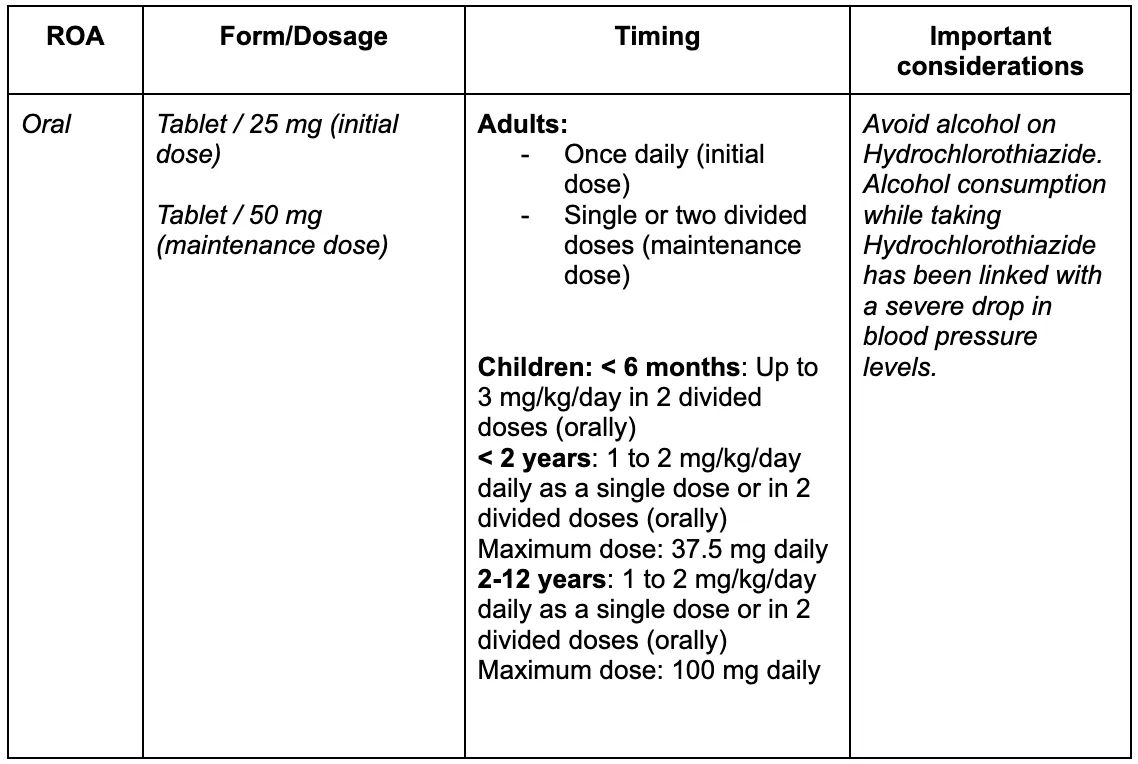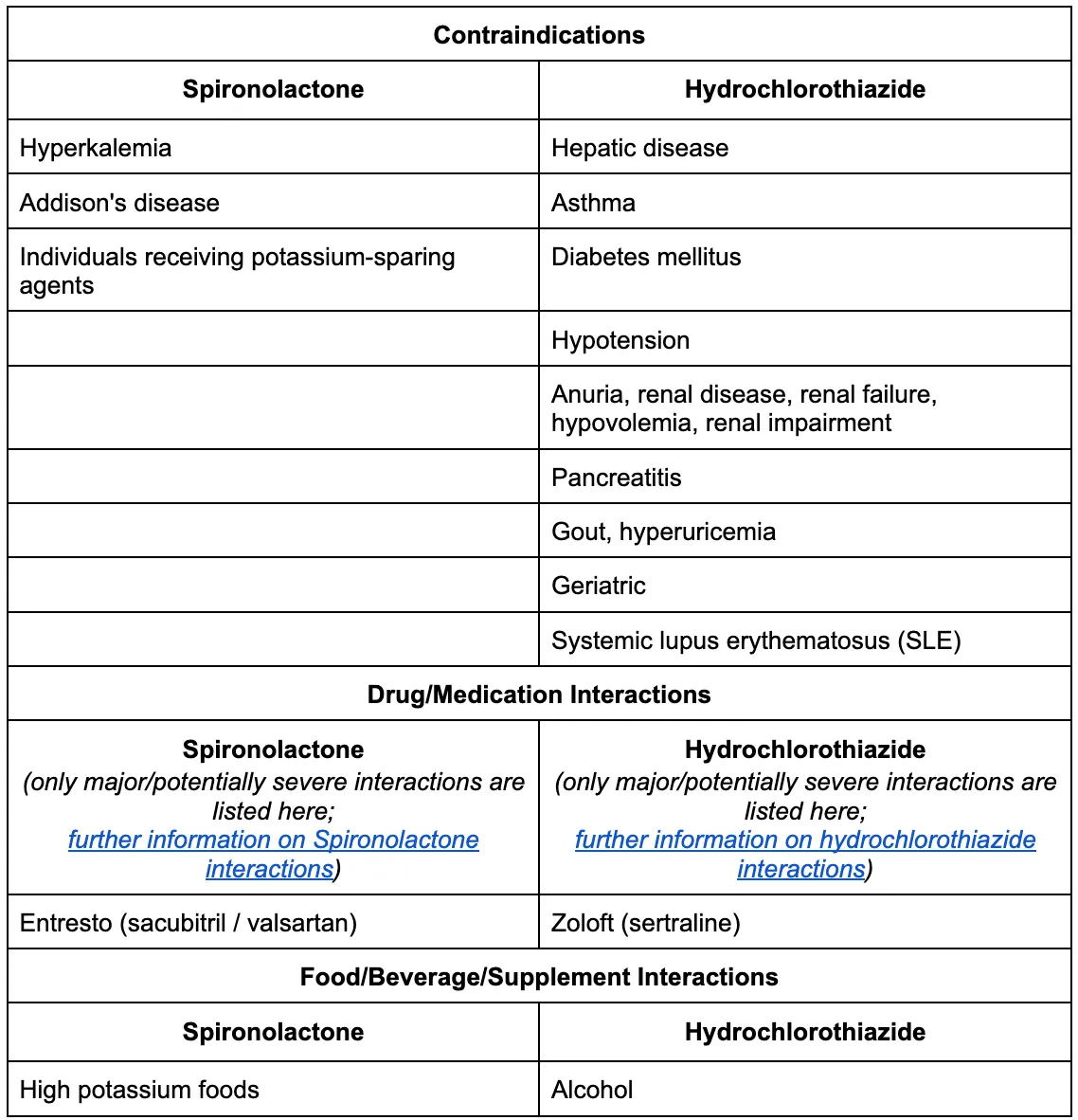Your session is about to expire
Spironolactone vs Hydrochlorothiazide
Introduction
According to WHO, approximately 1.28 billion adults between the ages of 30 to 79 years worldwide have hypertension. Spironolactone and Hydrochlorothiazide are two common drugs prescribed to hypertensive patients to help them control their blood pressure levels. These drugs work by preventing our bodies from absorbing excessive salt.[1]
About Spironolactone and Hydrochlorothiazide
What is Spironolactone?
The FDA (Food Drug and Administration) approved Spironolactone in 2001. Spironolactone is a potassium-sparing diuretic prescribed to individuals with hypertension, cardiovascular disease, or hypokalemia. It is widely administered as an oral tablet and is available under the name Aldactone and as a generic drug. It is only available on prescription.[2][3]
What conditions is Spironolactone approved to treat?
Spironolactone is approved to treat several conditions, including[4]:
- Hypertension
- Heart failure
- Low potassium levels
- Hyperaldosteronism
- Kidney disease
- Liver disease
How does Spironolactone work for Hypertension?
Spironolactone is classified as an antagonist of the aldosterone receptor. This medication works by binding receptors in the distal convoluted renal tubule's sodium-potassium aldosterone-dependent exchange location. This causes the kidneys to produce higher water and sodium levels, helping reduce hypertension levels.[5]
What is Hydrochlorothiazide?
The FDA (Food Drug and Administration) approved Hydrochlorothiazide in 1977. Hydrochlorothiazide is a drug commonly prescribed to patients with hypertension, Edema, and kidney, heart, and liver disease. It belongs to a group of medications labeled as diuretics. This class of drugs encourages the kidney to excrete unwanted fluid and salt from the body through the urine. Hydrochlorothiazide is only available on a prescription basis.[6]
What conditions is Hydrochlorothiazide approved to treat?
Hydrochlorothiazide is approved to treat several conditions, including[7]:
- High blood pressure
- Edema (swelling) caused by heart failure, cirrhosis (liver damage), or taking drugs called estrogens or corticosteroids.
- Edema caused by kidney-related conditions
- Heart failure
How does Hydrochlorothiazide work for Hypertension?
Hydrochlorothiazide helps to lower blood pressure by targeting the distal convoluted tubules and blocking the sodium chloride co-transporter mechanism. This has a diuretic effect, which decreases hypertension but results in potassium loss. The effects of the drug might begin as soon as 2 hours after consumption and peak in 4 hours, lasting 6 to 12 hours.[8]
Effectiveness
How effective are Spironolactone and Hydrochlorothiazide for treating Hypertension?
Spironolactone and Hydrochlorothiazide are known as effective drugs in treating uncontrolled hypertension levels. Several studies point toward the effectiveness of these drugs in treating hypertension. However, a study conducted in 2018 pointed toward the superiority of Spironolactone over Hydrochlorothiazide in the treatment of hypertension.
The study was conducted on 566 hypertension patients. A percentage of the participants were prescribed HCTZ (25 mg/qd), whereas others were prescribed spironolactone (25 mg/qd). The study lasted over 4 weeks, and its findings indicated that in patients with uncontrolled blood pressure levels prescribing spironolactone appeared to be a better course of action than prescribing HCTZ for systolic blood pressure control, cf-PWV reduction and preventing the development of resistant hypertension.[9]
Dosage information
How is Spironolactone administered for Hypertension?
Spironolactone is available in tablet and suspension (liquid) form. Both forms of the medication are meant for oral consumption and are usually prescribed to be taken once or twice daily.
Spironolactone dosage information
The following table includes information on Spironolactone dosage for hypertension[10]:

How is Hydrochlorothiazide administered for Hypertension?
Hydrochlorothiazide comes in two forms: tablet (capsule) and liquid solution; all meant to be taken orally. When used to treat hypertension, it is usually prescribed twice daily.[10]
Hydrochlorothiazide dosage information
The following table includes information on Hydrochlorothiazide dosage for hypertension[11]:

Side Effects
What are the most common side effects of Spironolactone?
The most common side effects of Spironolactone include:
- Fatigue (tiredness)
- Vomiting
- Restlessness
- Diarrhea
- Drowsiness
- Vaginal bleeding in post-menopausal (after the end of monthly menstrual periods) women
- Changes in voice (deepening of voice)
- Increased hair growth on different parts of the body
- Cramps and stomach pain
- Enlarged or painful breasts in men or women
- Irregular menstruation
- Difficulty maintaining or achieving an erection
Are there any potential serious side effects of Spironolactone?
Potentially serious side effects of Spironolactone include:
- Muscle pain, weakness, or cramps
- Decreased urination
- Flu-like symptoms
- Fainting
- Yellowing of the eyes or skin
- Unusual bruising or bleeding
- Lack of energy
- Loss of appetite
- Pain in the upper right portion of the stomach
- Rash
- Extreme fatigue (tiredness)
- Excessive thirst, dry mouth, headache, dizziness, unsteadiness, or other signs of dehydration
- Hives
- Itching
- Vomiting blood
- Blood in stools
- Difficulty breathing or swallowing
- Numbness, burning, pain, or tingling in the feet or hands
- Inability to move legs or arms
- Changes in heartbeat
- Confusion
- Nausea
Important note! If you experience any of the above serious side effects, seek medical help immediately.
What are the most common side effects of Hydrochlorothiazide?
The most common side effects of Hydrochlorothiazide include[12]:
- Cramping
- Spinning sensation
- Severe sunburn
- Weakness
- Difficulty having a bowel movement (stool)
- A constant movement of surroundings or self
- Thinning of hair
- Hair loss
- Redness or discoloration of the skin
- Restlessness
- Difficulty having or keeping an erection
- Enhanced skin sensitivity to sunlight
- loss in sexual drive, performance, desire, or ability
- Muscle spasms
- Decreased Libido (need to be sexually active)
Are there any potential serious side effects of Hydrochlorothiazide?
Potentially serious side effects of Hydrochlorothiazide include:
- Leg, stomach, or back pains
- Bloating
- Blood in the stools or urine
- Blue fingernails and lips
- Black, tarry stools
- Bleeding gums
- Unusual weakness or tiredness
- Increased urination
- Indigestion
- Peeling, loosening, or blistering of the skin
- Blurred vision
- Itching, numbness, crawling, burning, prickling, or tingling feelings
- Chest tightness or pain
- Chills
- Clay-colored stools
- Cloudy urine
- Dry mouth
- Difficult, noisy, or fast breathing
- Difficulty swallowing
- Lightheadedness, dizziness, or faintness when getting up from a sitting or lying position
- Cold sweats
- Vomiting of blood
- Coughing up blood
- Heaviness or weakness of the legs
- Weight gain
- White, waxy, or yellow scar-like area
- Muscle pain or cramps
- Vomiting or nausea
- Nosebleeds
- Pain, numbness, weakness, or tingling in the hands
- Yellowing of eyes or skin
- Confusion
- Constipation
- Cough or hoarseness
- Coughing that sometimes produces a frothy pink sputum
- Cracked skin
- Darkened urine
- Decrease in the urine-concentrating ability
- Decreased amount or frequency of urine
- Diarrhea
- Fast or irregular heartbeat
- Fever
- Pink growth
- Flushed, dry skin
- Fruit-like breath odor
- Generally swollen body
- A general feeling of illness or discomfort
- Swelling or puffiness of the eyelids or around the face, eyes, lips, or tongue
- Decreased frequency of urination or amount of urine
- Difficulty or pain during urination
- Pains in the side or stomach (possibly radiating to the back)
- Pale skin
- Persistent non-healing sore
- Pinpoint red spots on the skin
- Red, irritated eyes
- Increased sweating
- Increased thirst
- Red skin lesions (purple center)
- Red, swollen skin
- Loss of heat from the body
- A reddish patch or irritated area
- Soreness, redness, or scaly skin
- Sores, blisters, or welting
- Swelling of the legs, ankles, face, fingers, feet, or lower legs
- Unpleasant breath odor
- Painful or swollen glands
- Tender salivary glands
- Thickening of bronchial secretions
- Unusual bruising or bleeding
- Joint pain, stiffness, or swelling
- Appetite loss
- Lower side or back pain
- Trembling
- Seizures
- Trouble breathing
- Shiny bump
- Sore throat
- Unusual weight loss
- Headaches
- Itching, rash, hives
- Increased hunger
- Ulcers, sores, or white spots on the mouth or lips
Important note! If you experience any of the above serious side effects, seek medical help immediately.
Contraindications and interactions
Warnings and general precautions for Spironolactone and Hydrochlorothiazide
Spironolactone and hydrochlorothiazide can cause severe allergic reactions in rare cases. It is important to tell your healthcare provider if you are allergic to these medications or any other thiazide diuretics. It is also critical to share with your doctor if you are breastfeeding, pregnant, or becoming pregnant when taking Spironolactone and hydrochlorothiazide.
Spironolactone has been known to cause tumors in laboratory animals during testing. Talk to your healthcare provider about the risks attached to this medication and its benefits for your health condition.[13]
Contraindications and important interactions for Spironolactone and Hydrochlorothiazide

Cost Comparison
How much do Spironolactone and Hydrochlorothiazide cost?
25 mg Spironolactone oral tablets cost approximately $13 (30 tablets), whereas 25 mg hydrochlorothiazide oral tablets cost approximately $10 (7 tablets). On the other hand, 25 mg hydrochlorothiazide/spironolactone oral tablets cost approximately $23 (30 tablets). These values can vary depending on your location and the pharmacy you visit. [14]
Popularity of Spironolactone and Hydrochlorothiazide
Both spironolactone and hydrochlorothiazide are popular drugs prescribed for the treatment of hypertension. However, in recent years, the popularity of spironolactone has decreased due to its tendency to cause tumors and estrogenic side effects. Hydrochlorothiazide remains one of the most popular thiazide diuretics prescribed to treat hypertension.[15]
Conclusion
Takeaway
Both spironolactone and hydrochlorothiazide have a promising track record of treating hypertension and several other diseases. In some cases, doctors may also combine both drugs to treat uncontrolled hypertension levels in patients effectively. However, hydrochlorothiazide is more popular than spironolactone.
Spironolactone tumor-causing and estrogenic side effects make it a less sought-after treatment for hypertension. It is important to share your medical history and any medications you might be taking, including other relevant information, with your doctor to help them decide which drug to prescribe for your hypertension treatment.